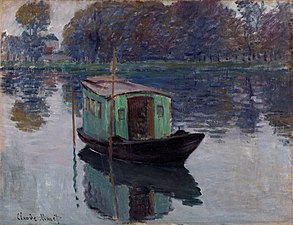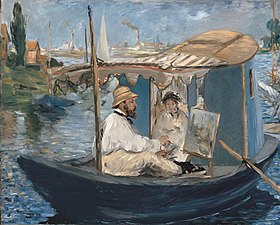User:Spiderman711/sandbox
The Studio Boat (Le Bateau-atelier) is a painting done in the impressionist style in 1876 by the French artist Claude Monet. The work depicts Monet at work in his studio boat on the Seine river in Argentueil.[1] It was executed en plein air in oil on canvas with a size of 72 by 58.9 cm and currently belongs in the collection of the Barnes Foundation of Philadelphia.[2]
Monet bought the boat around 1873 soon after moving to Argenteuil. In his own words he described the boat as "a cabin made out of planks were I had just enough room to set up my easel."[1] Monet most likely modeled his studio boat on the studio boat used by his friend and contemporary Charles François Daubigny.[2] The floating studio enable Monet to paint views from the River Seine in the Argenteuil district that were otherwise inaccessible, commencing with a series of paintings of the sailing boats at Petit-Gennevilliers.[3]
Monet lived by his beloved Seine throughout his life and painted his studio boat on several occasions, both at Argenteuil and at Giverny, where he later lived. He was also pictured by his friend and protégé Édouard Manet working on the boat in 1874 in the company of his wife Camille.
Motivations
[edit]Monet had multiple economic motivations for painting this work. During the 1970s, Monet embraced the growing trend of working en plein air as well as shifted to using smaller canvases in order to make his works easier to sell to the growing middle class during this time period.[1] During the 1850s, sail boats became an affordable pastime for the bourgeoise class in Europe, which Monet was a part of. Monet's frequent painting of boating scenes on the Seine such as this one are believed to be an appeal by Monet to create works that would be consumed by the growing middle class.[4] This work specifically believed to be inspired by an etching by Charles François Daubigny called Gulping it Down (Luncheon on the Boat) created in 1861.[1]
However, Monet's artistic motivations for this work were also at play. It has been pointed out that this work marks a shift in Monet's en plain air style of art. His depiction of himself at work in his studio boat demonstrates that the scene was not painted completely from observation, marling the beginning of Monet's movement beyond the Impressionist style. Scholars have suggested Monet did this to highlight the "creative role of the artist" within the work.[2] Additionally, Monet's depiction of this idyllic river scene points to the movement of his artistic inspiration away from depicting industrial and urban scenes. Instead, Monet choses to focus on natural scenery in which he "retreats to the untrammeled past" and tends to focus on the themes of isolation and contemplation.[5]
Frequent Comparisons
[edit]

As previously mentioned, this work was believed to be directed inspired by Gulping it Down (Luncheon on the Boat) by Charles François Daubigny due to there similarities in content and capitalization on the increasing middle class interest in sailboats.[1] Also, The Studio Boat (Le Bateau-atelier) is frequently contrasted with Edouard Manet's painting Monet Working on his Floating Studio in Argentuil from 1874. Manet's piece is typically seen as the antithesis to Monet's self-portrait which portrays himself as confident and able to blend the nature scenes and urban, industrial scenes of Argenteuil with ease.[4] Additionally, due to Monet's move away from industrial scenes at this time in his career, his works at this time are compared to the prior Barbizon School of art which also focused on picturesque nature views.[5] This work has also been compared to some of Monet's later works due to their similarities in composition and style. Specifically, The Studio Boat (Le Bateau-atelier) has been connected to the artist's successful Mornings on the Seine series from the 1890s due to both works demonstrating Monet's move beyond the Impressionist style.[2]
Gallery
[edit]See also
[edit]- List of paintings by Claude Monet
- Claude Monet Painting in his Studio, 1874 painting of Monet in his boat
References
[edit]- ^ a b c d e House, John (1986). Monet: Nature into Art (2nd ed.). Guild Publishing. pp. 137–140.
- ^ a b c d Knopf, Alfred A.; Moffett, Charles S. (1993). Great French Paintings from the Barnes Foundation: Impressionist, Post-Impressionist, and Early Modern (1st ed.). New York City: Lincoln University Press. pp. 98–101. ISBN 0-679-74476-2.
- ^ Wildenstein, Daniel. Monet. p. 98.
- ^ a b Tucker, Paul Hayes (1982). Monet at Argentuil. New Haven: Yale University Press. p. 105. ISBN 9780300032062.
- ^ a b Tucker, Paul Hayes (1995). Monet: Life and Art. New Haven: Yale University Press. pp. 90–91. ISBN 9780300062984.
 | This is a user sandbox of Spiderman711. You can use it for testing or practicing edits. This is not the sandbox where you should draft your assigned article for a dashboard.wikiedu.org course. To find the right sandbox for your assignment, visit your Dashboard course page and follow the Sandbox Draft link for your assigned article in the My Articles section. |




